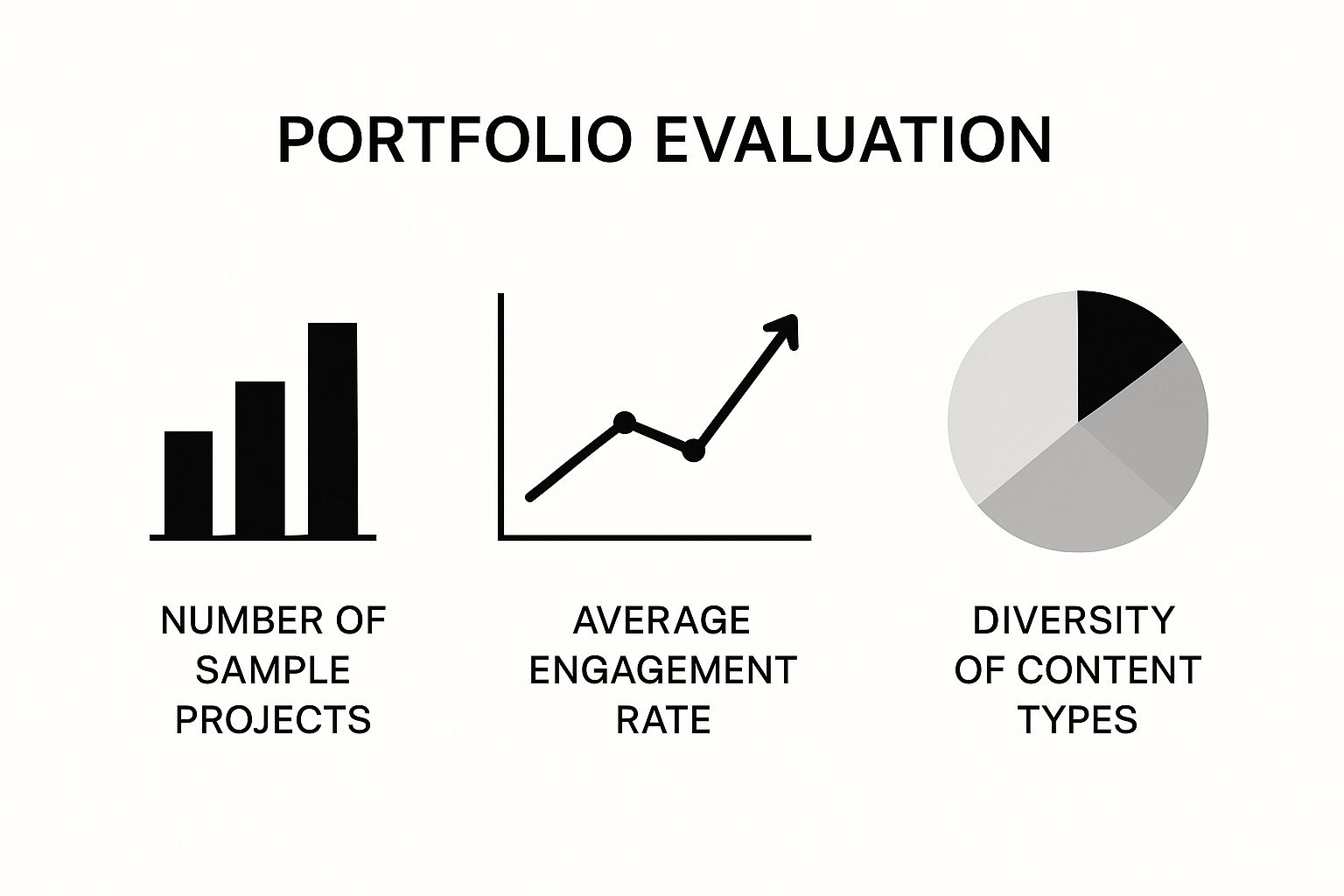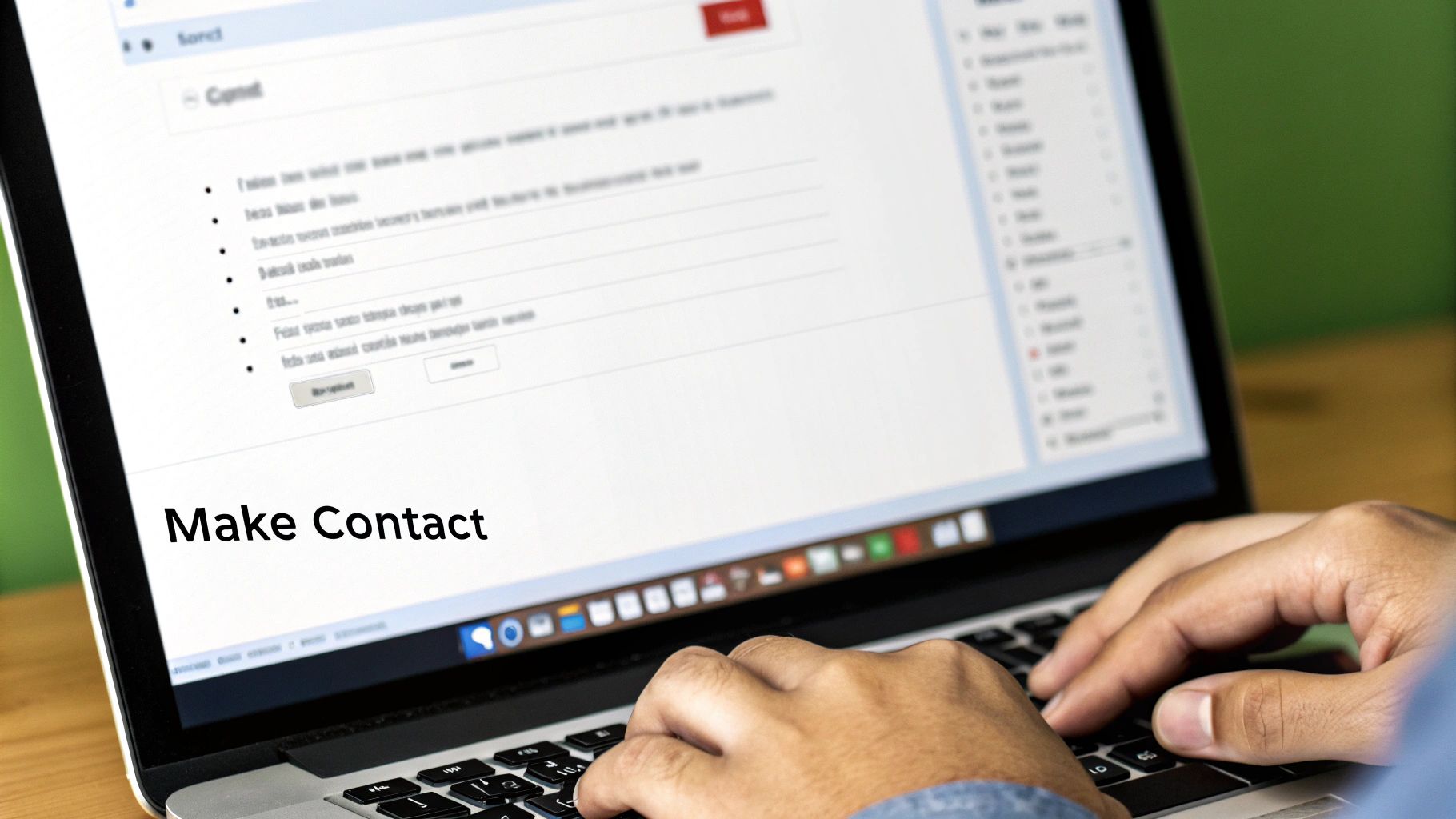Questions & Answers
We're here to help you get the most out of viral.app.
Mike Schneider
Co-Founder
A strategic guide to discovering, vetting, and partnering with the right creators for your brand's growth.

Finding the right content creators is a strategic game. It starts long before you ever type a name into a search bar.
The best partnerships come from a blend of smart planning, some good old-fashioned manual searching on TikTok and Instagram, and then scaling up your efforts with discovery tools like viral.app. Get this foundation right, and you'll find partners who actually click with your brand and deliver results you can measure. For Instagram specifically, there are additional proven strategies for finding influencers you should know about.
Jumping straight into a creator search without a plan is like sailing without a map. Sure, you might hit land eventually, but it probably won't be where you intended to go.
The most successful brand-creator collaborations I've seen were all built on a rock-solid strategy. This initial planning isn't just busywork; it's what stops you from burning time, money, and energy on partnerships that are doomed from the start. It all begins with getting crystal clear on who you're trying to talk to.
Before you can find the right creator, you have to understand their audience.
Think of this like building a character profile for your perfect partner. It's about so much more than just follower counts. You need to dig into the qualities that make a creator a genuine fit for your brand's voice and values.
I always recommend focusing on these elements:
Once you know who you're looking for, you need to define what you want to achieve. Vague goals like "increase awareness" are basically useless. You need specific, measurable objectives to know if a campaign was a win or a waste.
A well-defined goal is the difference between a partnership that feels good and one that proves its value. "Increase user-generated content by 30%" is a real goal. "Get more engagement" is just a wish.
Your budget is going to dictate everything. It directly shapes the kinds of creators you can even approach. The creator economy is a beast, projected to blow past $528 billion by 2030 with over 207 million creators in the mix.
But here's the reality check: only 4% of creators actually earn over $100,000 a year. That means there's a massive spectrum of pricing and experience out there. A clear budget helps you focus your search on the right tier of creators from day one. You can learn more about these creator economy statistics and what they mean for brands like yours.

Discovery tools are amazing for efficiency, but let's be real—nothing beats the intuition you get from rolling up your sleeves and digging for talent yourself. This hands-on approach is how you get a genuine feel for a niche, something an algorithm can't fully replicate. It's how you spot the rising stars before they’re on everyone else's radar.
Getting started is easy enough, but the real skill is moving beyond the obvious. Think of yourself as a digital detective, following clues to find creators who are a perfect match for your brand's DNA.
Your first instinct might be to search for the most direct terms. If you sell vegan protein powder, you’ll probably start with #veganprotein. That's a decent start, but it's also exactly what every single one of your competitors is doing.
The real gold is hidden in the adjacent communities where your ideal customers hang out. What else are they interested in?
#plantbasedrecipes#veganmealprep#postworkoutfuel#meatlessmondayideasFollowing these less-obvious hashtag trails often leads you to creators with hyper-engaged, niche audiences who haven't been bombarded with brand deals yet. That’s where you find authenticity.
Your competitors' collaborations are a public-facing case study. Don't just glance at who they're partnering with—analyze why a collaboration did or didn't work. Check their tagged photos or search their brand name to see who is talking about them, whether it's a paid post or organic love.
As you sleuth around, ask yourself a few key questions:
This isn't about copy-pasting their strategy. It’s about learning from their public experiments to sharpen your own. You get all the insights without spending a penny of your own budget.
The sheer number of creators out there can feel like a lot, but it’s a massive opportunity. With over 165 million people having joined the creator economy since 2020, the talent pool is deeper than ever. YouTube alone is home to over 64 million creators, and a solid 35% of all creators have been at it for 3-5 years, giving them a mix of experience and fresh energy. You can dig into more of these fascinating numbers in these content creator statistics.
Every platform has its own set of tools that can give your manual search a serious boost.
On TikTok, for example, the Creator Marketplace is a surprisingly powerful and free resource. You can filter creators by their niche, where their audience is located, and a lot more. Over on Instagram, you can use the "Suggested for you" feature to your advantage. Just follow a handful of creators who feel like a perfect fit, and the algorithm will start serving you similar profiles.
Mastering the manual search is a fundamental skill. It sharpens your instincts and ultimately helps you find those perfect-fit creators that no automated tool ever could.
Manually searching for creators is a great way to build an instinct for what works in your niche, but let's be honest—it doesn't scale. When you need to find dozens of creators, manage multiple campaigns, and justify your decisions with hard data, you need to bring in technology.
This is where creator discovery platforms come into play. Think of them as a specialized search engine, but for influencers and UGC creators. They give you a massive, searchable database you can filter with a precision that’s just not possible by hand. You stop hoping to stumble upon the right person and start systematically identifying them.
The real magic of discovery platforms is in the advanced filtering. Forget just searching by hashtags. You can now drill down into the metrics that actually predict a successful partnership.
For instance, you can find creators whose audience is a mirror image of your ideal customer.
This infographic shows a few key metrics you can use for a quick side-by-side comparison, like portfolio size, engagement rates, and the variety of content they produce.

A creator with a slightly smaller but highly engaged audience and a diverse portfolio is almost always a better bet than a bigger account with stale, repetitive content.
Of course, finding creators is just one piece of the puzzle. There are several ways to go about it, from manual searches on social media to working with agencies. Here's a quick comparison of the most common methods.
| Sourcing Method | Best For | Pros | Cons |
|---|---|---|---|
| Discovery Platforms | Scaling campaigns efficiently with data-driven decisions. | Massive, filterable database; access to performance data; streamlined workflow. | Subscription costs; can be overwhelming without a clear strategy. |
| Manual Searching | Early-stage brands developing a feel for their niche. | Free; helps build intuition; uncovers authentic, undiscovered talent. | Time-consuming; difficult to scale; lacks reliable performance data. |
| Creator Marketplaces | One-off projects or brands needing specific content types. | Direct connection to creators; often transactional and quick; clear pricing. | Can be less about relationships; variable creator quality; limited vetting. |
| Creator Agencies | Brands with larger budgets who want a hands-off, managed service. | Fully managed service; access to vetted, professional creators; strategic guidance. | Most expensive option; less direct control over creator selection. |
Each method has its place, but as you grow, the efficiency and data offered by platforms become indispensable for making smart, scalable decisions.
The best platforms, like viral.app, don't just stop at discovery. They offer an end-to-end system for managing your entire campaign. This is a game-changer for saving time and avoiding logistical nightmares.
You’re no longer juggling spreadsheets, email chains, and payment reminders. Everything moves to a single, organized dashboard. This frees you up to think about strategy, not admin.
Imagine handling outreach, contract negotiations, content approvals, payments, and performance analytics all in one spot. It’s not just about being more efficient; it's about getting a crystal-clear, data-backed view of your campaign ROI.
The money flowing through this ecosystem is staggering. North America's creator economy is projected to hit $32.28 billion in 2025. Platforms that make this commerce easier, like Shopify, have seen revenues over $5.2 billion from these creator-led activities. It’s no wonder so many brands are turning to platforms for efficient matchmaking. For a deeper dive, you can explore more on the booming creator economy market size.
Choosing the right platform comes down to your budget and specific needs. Some are all-in-one solutions, while others are more niche. If you're looking for more creator-focused tools, the resources over at the Makerbox homepage are worth a look. Ultimately, adopting a platform is a strategic move that gives you the tools to scale your efforts and prove the value of your work.

So you've found a creator with a follower count that looks promising. Great. But that's just step one. The real work—the part that actually protects your brand and your budget—is the deep dive that comes next.
A pretty profile can easily mask a disengaged audience or a history of flaky behavior. This is where you move from simple discovery to serious due diligence. Skipping this is a classic, and often expensive, mistake. You have to look past the vanity metrics to understand who you’re really about to partner with.
Let's be honest: a big follower number looks good on paper, but it can be a total vanity metric. A creator's true value is in the connection and trust they've built with their community. Focusing on the right signals is how you spot the difference.
Look for these signs of a real, engaged community:
A creator's engagement rate is so much more important than their follower count. An account with 10,000 dedicated followers who hang on their every word will drive more sales than an account with 100,000 passive (or fake) followers ever could.
Before you even think about hitting that "send" button on a collaboration email, you need to become a student of their content. This isn't just about a quick glance; it's a full audit to confirm quality, consistency, and—most importantly—brand safety.
Scroll back. No, further back. Go back months, not just a few weeks. Is their content consistently high-quality, or is it a random mix of hits and misses? Look at their production value, their storytelling ability, and the overall vibe. Does it feel like a good match for your brand's standards? It's also smart to understand their creation process. For instance, knowing how content creators might leverage AI tools can give you insight into their workflow and efficiency.
Next, stalk their past brand collaborations. Did they deliver professional, on-brief content? Pay close attention to how they disclosed the partnership—properly following FTC guidelines shows a level of professionalism you want. A solid track record of transparent, successful partnerships is a massive green flag.
Of course, once you've done the hard work of vetting, managing those relationships effectively is the next challenge. A good influencer relationship management strategy is what separates a one-off campaign from a long-term, high-value partnership. This initial audit is what makes it all possible.
Finding the perfect creator is only half the battle. If your first message lands flat, the partnership is over before it even begins.
Top creators are drowning in DMs and emails. Seriously, their inboxes are a warzone. A generic, copy-pasted pitch is a guaranteed way to get your message sent straight to the trash folder. Your goal is to stand out by being personal, professional, and genuinely interesting.
This first touchpoint sets the tone for everything that follows. Nail it, and you're not just getting a reply—you're starting a real relationship.
Before you even think about writing, do some real homework. A little effort here shows you see them as a creative partner, not just another number on a spreadsheet.
Go watch their content. Find a specific video, a clever editing trick, or a recent project that genuinely impressed you.
Instead of the lazy, "I like your content," try something specific: "Your recent TikTok on budget-friendly meal prep was brilliant—that jump-cut sequence in the first three seconds was so smart." This tiny detail proves you’ve actually paid attention and immediately builds rapport.
A personalized first sentence can be the difference between an enthusiastic "Let's talk!" and being instantly archived. It shows respect for their craft and separates you from the 90% of outreach that feels like spam.
Once you've hooked them with a personal touch, your message needs to be clear, concise, and compelling. Don't make them hunt for the important details, especially since they’re probably reading it on their phone between takes.
Keep it scannable and get straight to the point. Every great first message needs to cover three things:
Getting this right takes practice. You can find some solid starting points in these effective influencer outreach email templates and adapt them to your brand’s voice.
For a more plug-and-play solution, our complete influencer outreach template gives you a proven framework you can put to work immediately.
Jumping into the world of creator collaborations brings up a lot of questions. It's totally normal. As you figure out how to find the right content creators, you’ll probably hit a few common roadblocks around what to budget, how to vet people, and how to know if any of it is actually working.
Let's walk through some of the most frequent questions we hear from brands. Getting these answers straight will help you build a smarter, more effective strategy right from the start.
This is usually one of the first things brands ask, and the answer really shapes your entire strategy. It’s about way more than just follower counts—it’s about what you’re trying to achieve.
Micro-influencers, who generally have between 10,000 and 100,000 followers, are gold for their high engagement and tight-knit communities. Their audience genuinely trusts them, almost like a friend, which makes their recommendations feel incredibly authentic. They are fantastic for driving targeted sales and building real brand loyalty.
Macro-influencers, on the other hand, have huge audiences, typically from 100,000 up to a million followers (or more). Their superpower is massive reach and getting your brand name in front of as many eyeballs as possible. If your main goal is broad-stroke brand awareness, a macro-influencer is a great bet.
Honestly, the smartest strategies often use a mix of both. You might kick off a campaign with a macro-influencer for that big splash, then follow up with a team of micro-influencers to drive deeper engagement and convert that awareness into sales.
This is the million-dollar question, isn't it? Creator rates are notoriously all over the place. They can swing wildly based on follower count, engagement metrics, their specific niche, and exactly what you're asking them to do.
A classic rule of thumb is the "one cent per follower" guide, which shakes out to about $100 per 10,000 followers for a single Instagram post. But treat this as a very rough starting point, not a hard rule. A creator with off-the-charts engagement or a highly specialized skill set can, and should, charge more.
The best way to get a real number? Just ask for their media kit. It’ll lay out their standard rates. Don’t be afraid to negotiate, but always come in with a fair offer that shows you respect their craft and their audience.
Vetting is where you protect your brand from a partnership headache. A few key red flags can save you a world of trouble down the road.
The most obvious red flag is a massive follower count with laughably low engagement. If an account has 200,000 followers but their posts are a ghost town with just a few "nice pic!" comments, you're likely looking at fake followers or a completely checked-out audience.
Other things to keep an eye out for:
Measuring your return on investment is non-negotiable. You have to track performance against the specific goals you set at the beginning.
If your goal was brand awareness, you’ll be watching metrics like reach, impressions, and engagement rate. If it was driving sales, tracking gets much more direct. Use unique discount codes, custom affiliate links, or dedicated landing pages to see exactly how much traffic and revenue each creator is driving. By getting a handle on the ROI of influencer marketing, you can calculate your Cost Per Acquisition (CPA) and actually prove the financial impact of your campaigns.
At viral.app, we take the guesswork out of this whole process. Our platform gives you the tools to discover partners with genuine, engaged audiences and then measure every single aspect of your campaign's performance. It’s all about making sure your investment delivers real results. Find out how we can help you scale at viral.app.
We're here to help you get the most out of viral.app.
Become an expert in UGC marketing today leveraging our industry knowledge and unique tools.